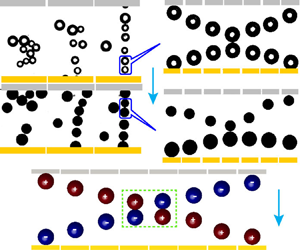Article contents
Genesis of electric field assisted microparticle assemblage in a dielectric fluid
Published online by Cambridge University Press: 09 March 2021
Abstract

Oscillatory motions of charged particles inside a liquid medium have been explored under the influence of an electric field emulating field-induced particle-laden fluid flows. The properties of the surrounding fluid are found to play key roles in the kinetics of such a particle aggregation process. While the weakly conducting or insulating liquids promote high-frequency oscillations of charged particles followed by a quick assemblage, the viscosity and relative permittivity of the liquid play significant roles in modulating the time scale. In fact, the origin of such motions in a multi-particle system is very similar to a system with a single charged particle wherein the particle gathers charge from one of the electrodes before moving towards the other of opposite polarity. Interestingly, in the multi-particle system, an unprecedented charge reversal is observed wherein a charged particle reverses its direction of motion after colliding with another particle of opposite polarity. Experiments together with simulations further reveal that, while the equal-sized particles undergo an electric field driven ‘elastic’ collision and show synchronized motions with nearly similar speeds of approach and separation, the motions of unequal-sized particles are rather non-uniform after undergoing an ‘inelastic’ collision. Importantly, the simulations with two-particle systems uncover the presence of counter-rotating vortices surrounding the charged particles. The results reported not only usher the genesis of the chain-like assemblage in the multi-particle systems but also open up the possibility of the generation of on-demand power-law liquid properties through ‘chaining’ or ‘layering’ of the charged particles.
- Type
- JFM Papers
- Information
- Copyright
- © The Author(s), 2021. Published by Cambridge University Press
References
REFERENCES
- 5
- Cited by



